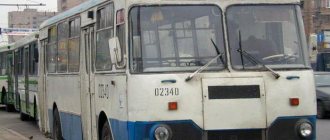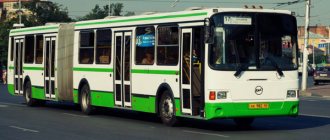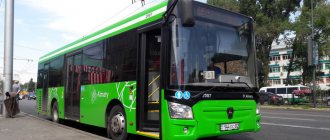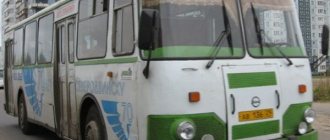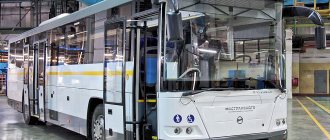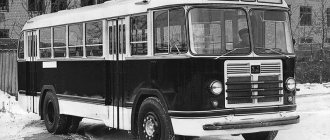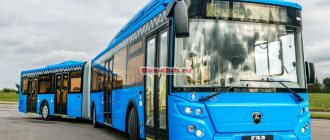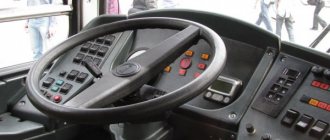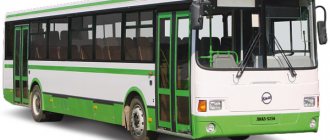Author: Kot shashlik
09 August 2022 09:27
Community: Autoworld
Tags: LiAZ 677 auto buses autoworld cars LiAZ public transport
6352
20
25 years ago, on August 8, 1994, the last, 194183rd LiAZ-677 bus rolled off the assembly line of the Likinsky Bus Plant. Its conveyor life lasted 27 years: the first commercial vehicles entered Soviet fleets in 1967, and a full generation change occurred three years later, when the previous model, ZIL-158v, was discontinued in 1970. I thought for a long time about how to celebrate this anniversary - and decided to move from the controversial Moscow summer of 2019 to the hot Krasnodar summer of 2012. It was then that I had the opportunity to meet the exemplary 677, still flashing on the streets of Krasnodar. By the way, at the time of filming the hero is the same 25 years old; it was built in the first half of 1987.
Our days, warm January evening
0
Source:
The Kuban Ghost is also a service delivery vehicle, but is kept in good health and is in no hurry to retire. He, together with an equally aged LAZ, transports the staff of an agricultural research institute, which is hidden on the outskirts of the city. As a rule, LAZ-695N operates in the warm season, and LiAZ is a bus for the cold season; exceptions to this rule occur if the “partner” undergoes repairs - therefore, the cars are not preserved even in the off-season, and long downtime does not happen for both.
0
Source:
The secret to the longevity of this LiAZ lies in its storage conditions. The research institute's delivery buses constantly live not only in a closed area, but also in a warm, heated room in the institute's garage. And the mild Kuban climate is very conducive to the longevity of any equipment, especially in direct hands (=
LiAZ-5930 PTS-4/LiAZ-5931 Lotus/LiAZ-5932 Magnolia
0
Source:
Separately, it is worth talking about mobile television stations built on the basis of the LiAZ-677 bus. In 1964, in connection with the commissioning of the television center under construction in Ostankino and the introduction of new generation television equipment, work began on the development of a mobile television station on the chassis of the new LiAZ-677 bus. In 1972, the first two specialized buses under the name PTS-4 were produced at the television plant in Siauliai. The station was intended to record television broadcasts from cultural events taking place on the street: concerts, rallies, parades. The chassis of the LiAZ-677 bus was equipped with a new all-metal welded van-type body, the walls and roof of which had additional thermal insulation. The roof of the bus was used as a platform for camera operators to operate. The reinforced steel panel could support up to three people and television equipment. To lift operators, a ladder was provided at the rear of the body, and to lift the necessary equipment, a winch with a lifting capacity of 60 kg was used. To ensure that the bus stood stably on the surface during operation, the driver extended outrigger support devices. Inside the bus there were consoles for the director, video engineer and sound engineer, six folding and five swivel seats, hangers with clothes, a table, a telephone and two wardrobes. To increase the comfort of working inside the bus, a forced ventilation system was developed that uses heat from the engine radiator for heating in winter, and in summer the cabin was cooled by two KT-4 air conditioners, powered in parking lots from an external network. The luggage compartments contain transformers, cable winding mechanisms and a shield for audio cables. The special bus LiAZ-5931, which received its own name “Lotos”, differed from the early model 5930 only inside: the Lotus had equipment for recording color pictures for television. The cars were produced in small batches at the Siauliai plant until 1974, where they were subsequently replaced by a new television station, designated LiAZ-5932 Magnolia. It differed from its predecessors in its improved television equipment, thanks to which it could immediately transmit live broadcasts. The Magnolia plant produced small batches until 1982.
0
Source:
Separately, it is worth noting that to service the PTS, an auxiliary bus was used, which accompanied the station during operation and was a converted LiAZ-677 for transporting television cameras, tripods, cables and other necessary equipment. In addition, the bus was used as a utility room for station staff, and only the front three-seater sofas were usually left in the passenger compartment.
The beast crawls out of the garage
0
Source:
Then, 7 years ago, the incredible happened: my Krasnodar friends managed to agree with the institute that the old LiAZ would be provided for a whole day for a trip around the city with a group of transport enthusiasts. This is not the first time that local transport workers have practiced this: in the old days in Krasnodar people gathered for rides on something that was sold out every year, while rarities remained in use; but before that, buses were provided by transport companies - and, characteristically, completely free of charge. But due to the long-term lack of other 677s in Kuban, the organizers of the event in 2012 had to turn to the happy owners of this very car - and they also succeeded.
LiAZ-677M
0
Source:
LiAZ engineers started thinking about serious modernization of the bus back in the mid-1970s. In 1975, a pilot batch of 35 buses was built, which featured a different front design with a plastic grille, and the door leaves were made of aluminum alloy. Inside, the main change was a new truss frame with increased rigidity. In the photo: LiAZ 677M pre-production
0
Source:
0
Source:
Changes also affected the transmission. The hydraulic transmission has been significantly strengthened, and the installation of a rubber coupling has reduced vibration levels and increased the service life of universal joints. New components appeared in the braking system, which allowed it to meet modern safety requirements. Buses began to be equipped with sunroofs, initially typical only for suburban modifications, “entry/exit” windows above the doors disappeared, replaced by a blank steel panel, some side windows were turned into emergency ones and were deprived of vents, and the old rear axle of the Hungarian company Raba was replaced with a modern one of the same brand, with different gear ratios, reinforced gearbox and axle shafts. To improve the driver's working conditions, new sealing materials were used, which made it possible to minimize gas pollution and noise in the cabin. The entire pilot batch went into operation at the Moscow automobile plants. It is known that several “Emoks” worked for many years in the first, second and fifth bus depots of the capital. However, the new front mask was considered unprofitable to produce, so the serial LiAZ-677M, put into production in 1982, differed from the “regular 677s” by an additional grille for cooling the engine at the front and a single ocher-yellow paint scheme, for many years years, which became the main one for the model.
0
Source:
Since 1984, new front and rear bumpers began to be installed on the bus, and new lighting equipment appeared that meets international requirements. At the rear, square lights appeared, consisting of four headlights: side lights, brake lights, reversing lamps and turn indicators, and at the front, in 1986, the front upper lights were replaced with rectangular ones. Changes also affected the interior. The driver got a new seat with its own suspension, adjustable in height, length, backrest and cushion tilt, the ventilation system and interior trim were changed: some of the elements were made of low-flammability plywood, and the seats were reupholstered with leatherette.
In the cabin
0
Source:
Seats, floors, trim - everything here is preserved perfectly! Even the shields placed at the doors, always mutilated and scratched, here reveal the venerable age of the car only with barely noticeable chips. The ribbed polymer coating on the handrails is perfectly intact, and only at the entrance is a small patch on the floor noticeable.
0
Source:
The only noticeable deviation from the original in the cockpit is the homemade braid on the steering wheel. Usually it was made from vinyl decorative inserts into moldings that stood in the interior and covered their fasteners - and such fashionable tuning was widespread throughout the former Soviet Union.
LiAZ-677B
The main modification of the bus that entered the assembly line in Likino in 1973 was the suburban LiAZ-677B. The bus differed from its “urban” counterparts in its four-row interior layout and the same floor level in the cabin. Sometimes it is mentioned that the main difference between the 677B externally and the urban version is the bracket for mounting the spare wheel at the rear of the body. Actually this is not true. The bracket was part of the standard equipment of any production bus. The fact is that in the event of hostilities, the LiAZ-677 was planned to be used as ambulance buses, the standard seats in which could easily be replaced with the included stretchers. Of course, the spare wheel in the interior, prepared for medical work, turned out to be superfluous and, according to the doctors’ requirements, was moved outside. In peacetime, the spare wheel and bracket, respectively, were stored on the territory of the ATP, and according to the rules, to replace the wheel it was necessary to call a technician from the park. In the photo: LiAZ-677B
0
0
0
0
The welded frame for all buses was the same; an additional section of the high floor was welded onto the standard frame. LiAZ engineers thought out a design that was maximally unified with the body of the existing urban version, without major changes to the production line, which, of course, would reduce the number of buses produced, while the country needed an increasing number of them every year. The rear truss contains guides for joining the floor frame for suburban modification. Two more guides are hidden in the area of the rear arches. To create a section of a flat floor, a frame was developed, welded from square pipes. To secure it to the power side members and body trusses, additional docking points were introduced, which were not dismantled if the bus was an urban modification. To accommodate the spare wheel under the floor, a hatch was constructed in the rear of the body, secured with two separate locks. For maximum unification in production, it was brought into line with the battery compartment hatch. For the same purpose, front door leaves were installed on suburban modifications, because the floor height in this case was identical to the front part. In total, the commuter version could accommodate up to 87 passengers, of which 35 were seated. Modification 677B was produced from 1973 to 1978; subsequently, its place on the assembly line was taken by the modernized version LiAZ-677MB, which had a similar design.
On the bend!
0
Source:
In 1994, the 677th seemed to be a hopelessly outdated machine, and worn-out equipment and the alarming situation both in the country and at the plant only accelerated its retirement. But the car remained in demand: after August 1994, LiAZ, which was knocked out, for some time continued to build bodies of the old model as “spare parts”, without a title, and the production of the still in demand 677s was transferred to a number of third-party enterprises. But the point of no return was passed: the conveyor belt for the construction of these machines was gradually dismantled.
LiAZ-677A
0
Source:
Especially for areas with a cold climate (from – 60 °C), the northern modification 677A was developed (after the modernization of the LiAZ-677MS), which differed from its analogues in double glazing, thermal insulation and a four-row interior layout. Buses were produced to order in small batches. To solve problems with increased fuel consumption, bus modifications were developed that ran on liquefied gas and were produced in small batches. The LiAZ-677G differed from its gasoline counterparts in a box with three gas cylinders on the roof, as well as reduced engine power due to the conversion to gas and, as a result, lower passenger capacity.
...and content
Even despite the outdated layout with a front engine and a voracious gasoline engine, the LiAZ-677 became a truly breakthrough car for its time. Judge for yourself: for the first time in the Soviet bus industry, the driver had at his disposal a full-fledged hydromechanical automatic transmission and power steering, and the place of a practically heavy-duty rigid spring suspension was taken by an air spring suspension. Wide doors, a spacious and bright interior - the new model was better than its predecessor in every sense.
Compared to the axe-simple ZIL-158, the new product seemed like a fantastically complex machine, too difficult to operate for Soviet automobile companies. Representatives of some of them even approached the plant and the ministry with a request to keep the time-tested model in production in parallel with the 677, but they were never heard.
The main disadvantage of the classic LiAZ has always been considered its insatiable appetite - there are 50-55 liters in the fork for a working bus, and tending to infinity for an overloaded or faulty one. There were two culprits for such high fuel consumption: the GMP-2 hydromechanical gearbox, whose efficiency was ridiculously low, and the ZIL-375 gasoline “eight” under the hood, borrowed from the army Ural. During the stagnant years in the Soviet country, gasoline was not particularly considered, and the main problem was considered to be the widespread theft of fuel and the inability to complete shifts without refueling. Everything changed with the first shortages of gasoline in the 1980s, and even more so after the collapse of the Union, when the issue of efficiency became very acute.
Since a suitable bus diesel engine was not produced in the USSR, the LiAZ designers introduced an already produced gasoline cargo engine into the new bus, which was most suitable for its characteristics. The heart of the “677th” LiAZ was the V-shaped eight of the ZIL-375YA7 model - essentially a forced version of the ZIL-130 engine, intended for the Ural-375 army all-terrain vehicle. It is important to note here: the terrible fuel consumption figures for LiAZ vehicles were often deliberately inflated in order to feed not only a bus, but also a couple of cars with the gasoline actually saved. During the era of gasoline shortages in the 80s and 90s, bus drivers made good money by reselling the drained fuel to taxi drivers and suffering private owners.
In the struggle for efficiency, the plant also experimented with diesel Lunokhods. Thus, at various times, diesel LiAZs were tested with experimental horizontal engines YaMZ-233, which were never implemented in the series, and even samples of “677s” with diesel engines RÁBA (Hungary) and Škoda-LIAZ (Czechoslovakia) were tested. None of these options ever went into production. Only in the 90s did auto repair companies and bus fleets begin to introduce diesel engines into old LiAZs, primarily the YaMZ-236 inline sixes, which were used mainly on MAZ trucks. After such a re-equipment, the LiAZ, although it acquired unusual efficiency and dynamics, became a noisy, cold and labor-intensive machine to repair. Often the replacement of the engine was accompanied by the elimination of the automatic transmission. In its place, fleets and ARZs introduced “mechanics” from various Soviet trucks, with which the bus became much faster and more economical.
In addition to the dieselization of LiAZs, experiments were also conducted with gas engine fuel. Their result was the appearance of the LiAZ-677G bus with a ZIL-138 engine running on propane. The gas cylinders of such a bus were placed under the floor, along the left side, and the gas tank was reduced to a small starting capacity. At a certain point, this model was considered unsuccessful and all existing cars were massively converted to use gasoline. So, the gas-powered LiAZs encountered in the post-Soviet years, and even more so with cylinders on the roof, are not factory products, but exclusively the creativity of the operators themselves.
The hydromechanical gearbox used on the 677 LiAZ deserves a separate story. It was produced in Lviv by a branch of LAZ and was developed for the LAZ-695 middle class bus. There, the GMF had to be connected directly to the engine, without intermediaries. On the LiAZ, not only is the engine not directly connected to the gearbox, but it is also not located on the same axis with the GMT and rear axle gearbox. To connect the engine to the gearbox, the LiAZ uses a clever system of cardans with intermediate supports - it is this that produces that very “clanging of bottles”, memorable to everyone who has ever encountered such a bus in person. There are several sources of this ringing: it is mainly produced by the hollow tubes of the cardans between the engine and the GMT. As it wears out, the bearing of the intermediate crosspiece of the propeller shaft between the engine and the gearbox begins to rattle, and the third member of the “orchestra” is the output bearing on the gearbox. It should be noted here that although the ringing appears as the transmission units wear out, it does not interfere with the bus’s operation, and its occurrence is not considered a malfunction.
When talking about the LiAZ “automatic”, it is impossible not to mention an important element of amateur modernization of the bus. In order to coast in neutral gear, saving fuel, drivers introduced a special forced neutral switch. Usually it was a household switch on the instrument panel or a less noticeable toggle switch on the panel or GMT selector. Coasting allowed you to significantly save gasoline in ragged city mode, and not so much to reduce fuel consumption, but rather to save gasoline in order to later use it in your pocket.
An alternative function of the panel switch could be to control the doors. To do this, an electric drive was installed directly on the doors, and the pneumatic valve located to the left of the steering wheel was removed from the dashboard. It often happened that the LiAZ had both a switch and a toggle switch on the panel. This meant that doors could be opened using a button rather than a tap.
In addition to the doors “in the air” from the pneumatic system, the LiAZ operates an air spring suspension. The use of pneumatics in the suspension gave the LiAZ a new, unprecedented level of comfort for passengers and a truly soft ride. On the other hand, as the suspension wore out, the benefit of civilization turned into a detriment: on uneven surfaces, passengers on the rear platform could fly up to the ceiling on bumps. But this is not a flaw in the design of the bus itself, but only a lack of operating culture. The problem of worn-out or even missing shock absorbers was of no interest to anyone: at our automobile enterprises, a malfunction that does not prevent the car from going on trips was never considered a malfunction.
Together with the air suspension, the LiAZ pneumatic braking system is also supplied with air. It is deprived of energy accumulators that slow down the bus when there is a loss of pressure, and therefore the “677”, left without air while on the move, will stop without major trouble only by a miracle. The driver of an out-of-control LiAZ will only have to rely on the parking brake and clear intersections ahead.
LiAZ-677 was one of the first Soviet cars to be equipped with power steering as standard. The steering mechanism with power steering for the LiAZ was borrowed from the army Ural, from the exotic model Ural-377 (6x4), produced until the 1970s.
The wheels on the classic LiAZ are discless, prefabricated, on wedges - their installation is fundamentally different from the cars we are used to, including trucks and buses. The steering axle on the “677” is marked as “LiAZ”, presumably, it was produced at the facilities of ZIL. As part of the CMEA cooperation, these axles were supplied to a number of enterprises both in the USSR and abroad: their main consumers, in addition to LiAZ and LAZ, were the Hungarian Ikarus and the Uritsky trolleybus plant.
The rear drive axle was produced at the RÁBA plant in Hungary and supplied to Soviet buses and trolleybuses within the framework of the same CMEA cooperation. This unit is fantastically reliable: the Hungarian bridge not only could not raise any questions during the entire service life of the bus, but could also survive several carrier vehicles!
On the other hand, after the collapse of the Eastern bloc and the chain of economic disasters in the early 1990s, RÁBA sharply reduced the supply of drive axles to the former USSR. LiAZ and LAZ then faced an acute shortage of drive axles, and for this reason they sharply reduced the production of finished buses. There was a period when customers picked up new buses at the plant, bringing used axles from decommissioned vehicles with them, or took away new “677s” in tow, on two steering axles, the rear of which was blocked. In this case, buyers installed a used bridge on their territory. At that time, other original solutions to the problem were also used: for example, the Likinsky plant produced a small batch of buses with the Bulgarian Madara drive axle, and repair plants built LiAZs with a drive axle produced by the Ishimbay plant.
